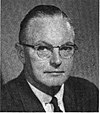The 20th congressional district of Ohio was created after the 1840 census. It was eliminated in the redistricting following the 1990 census, and redistricted and renumbered as the 10th district.
The 21st congressional district of Ohio was a congressional district in the state of Ohio. It was eliminated in the redistricting following the 1990 census.
The 22nd congressional district of Ohio was eliminated as a result of the redistricting cycle after the 1980 census.
The 24th congressional district of Ohio was created for the 1966 election, after the banning of at-large seats by the Voting Rights Act of 1965. It replaced Ohio's at-large congressional district. It was eliminated in the redistricting following the 1970 census. At the time of its creation, it consisted of the southwestern counties of Preble, Butler, Warren and parts of southern and eastern Montgomery.
Ohio's at-large congressional district existed from 1803 to 1813, from 1913 to 1915, from 1933 to 1953 and from 1963 until 1967, when it was banned by the Voting Rights Act of 1965.
Ohio's 11th congressional district encompasses portions of Cuyahoga County in the Northeast part of the state—including all of Cleveland. It has been represented by Shontel Brown since 2021.

Nebraska's 1st congressional district is a congressional district in the U.S. state of Nebraska that encompasses most of its eastern quarter, except for Omaha and some of its suburbs, which are part of the 2nd congressional district. It includes the state capital Lincoln, as well as the cities of Bellevue, Fremont, and Norfolk. Following the 2010 United States census, the 1st congressional district was changed to include an eastern section of Sarpy County; Dakota County was moved to the 3rd congressional district.
Ohio's 5th congressional district is in northwestern and north central Ohio and borders Indiana. The district is currently represented by Republican Bob Latta.
Ohio's 7th congressional district is represented by Max Miller. It is currently located in the northeastern section of the state, including southern and western Cuyahoga County, all of Medina and Wayne Counties, and a sliver of northern Holmes County.
Ohio's 8th congressional district sits on the west side of Ohio, bordering Indiana. The cities of Hamilton, Fairfield, Middletown, Springfield, Eaton, Greenville, Piqua, and Troy are part of the district. The district was represented by Republican John Boehner, the 53rd Speaker of the United States House of Representatives. On September 25, 2015, Boehner announced his resignation from the speakership and retirement from Congress, which became effective on October 31, 2015.
The 13th congressional district of Ohio is represented by Representative Emilia Sykes. Due to reapportionment following the 2010 United States Census, Ohio lost its 17th and 18th congressional districts, necessitating redrawing of district lines. Following the 2012 elections, the 13th district changed to take in much of the territory in the former 17th district, including the city of Youngstown and areas east of Akron.
The 14th congressional district of Ohio is in the far northeast corner of the state, bordering Lake Erie and Pennsylvania. It is currently represented in the United States House of Representatives by Republican Dave Joyce.
The 15th congressional district of Ohio is currently represented by Republican Mike Carey. It was represented by Republican Steve Stivers from 2011 until May 16, 2021, when he resigned to become president and CEO of the Ohio Chamber of Commerce. The district includes all of Franklin County that is not in the 3rd district, including Grove City, Hilliard, and Dublin. It then fans out to grab suburban and exurban territory between the state capital Columbus and Dayton, along with more rural territory south of Columbus.

The 16th congressional district of Ohio is an obsolete United States congressional district last represented by Representative Anthony Gonzalez (R). It was last located in the northeast of the state, covering Wayne County and with arms extending north into the suburbs of Cleveland, and east into Greater Akron and Stark County. The district was eliminated upon the swearing in of the 118th United States Congress on January 3, 2023, as the reapportionment after the 2020 census reduced the number of congressional districts in Ohio to fifteen.

The 18th congressional district of Ohio is an obsolete congressional district last represented by Republican Bob Gibbs. The district voted for the majority party in the House of Representatives in every election since 1954.
Pennsylvania's 29th congressional district was one of Pennsylvania's districts of the United States House of Representatives.
Michigan's 19th congressional district is an obsolete United States congressional district in Michigan. The first candidate elected from the newly created district was Billie S. Farnum in 1964. It was eliminated as a result of the redistricting cycle after the 1980 census.
Indiana's 10th congressional district was a congressional district for the United States House of Representatives in Indiana. It encompassed roughly the "Old City Limits" of Indianapolis from 1983–2003. The district was re-drawn after the 1980 census and eliminated when Indiana's representation in the House of Representatives fell from 10 to nine after the 2000 census.
North Dakota's 3rd congressional district is an obsolete congressional district in the state of North Dakota that was created by reapportionments in 1913, and eliminated by the reapportionments of the 1930 census in 1933. The district consisted of the western part of the state, and was made up of following counties: Divide, Burke, Renville, Ward, Mountrail, Williams, McKenzie, McLean, Dunn, Mercer, Oliver, Billings, Stark, Morton, Hettinger, Bowman and Adams.
Pennsylvania's 23rd congressional district was one of Pennsylvania's districts of the United States House of Representatives.





